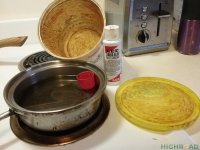I have generally avoided lead bullets for my reloading but decided to try some Missouri Bullet Co. 148 DEWC Brinell 12 for PPC velocity bullets.
I put together loads of 2.7, 2.8, 2.9 and 3.0 grains of Bullseye with CCI500 primers. The listed velocities for those loads was from 713 to just under 799fps. The OAL was 1.160.
I was shooting my 14-3 bullseye style, meaning slow and single action and was indoors, so the revolver was not hot at any point. I fired 100 rounds.
When I got home and cleaned the revolver there was leading in the chambers right at the throat, but there was no leading at all in the bore. I am not going to pretend to know much about lead bullets but I am surprised that there is leading in the throats but not in the bore.
I used Plug Gages to check the cylinder chambers and none would allow a .356 to pass through the throats. The .355 gage passed through 5 of the chambers but not through the 6th. I do not have a smaller plug gage.
The good news is all of the loads were accurate. The bad news is I dislike cleaning lead out and I have 900 more of these bullets left.
Where do I go from here to try and avoid leading?
I put together loads of 2.7, 2.8, 2.9 and 3.0 grains of Bullseye with CCI500 primers. The listed velocities for those loads was from 713 to just under 799fps. The OAL was 1.160.
I was shooting my 14-3 bullseye style, meaning slow and single action and was indoors, so the revolver was not hot at any point. I fired 100 rounds.
When I got home and cleaned the revolver there was leading in the chambers right at the throat, but there was no leading at all in the bore. I am not going to pretend to know much about lead bullets but I am surprised that there is leading in the throats but not in the bore.
I used Plug Gages to check the cylinder chambers and none would allow a .356 to pass through the throats. The .355 gage passed through 5 of the chambers but not through the 6th. I do not have a smaller plug gage.
The good news is all of the loads were accurate. The bad news is I dislike cleaning lead out and I have 900 more of these bullets left.
Where do I go from here to try and avoid leading?

